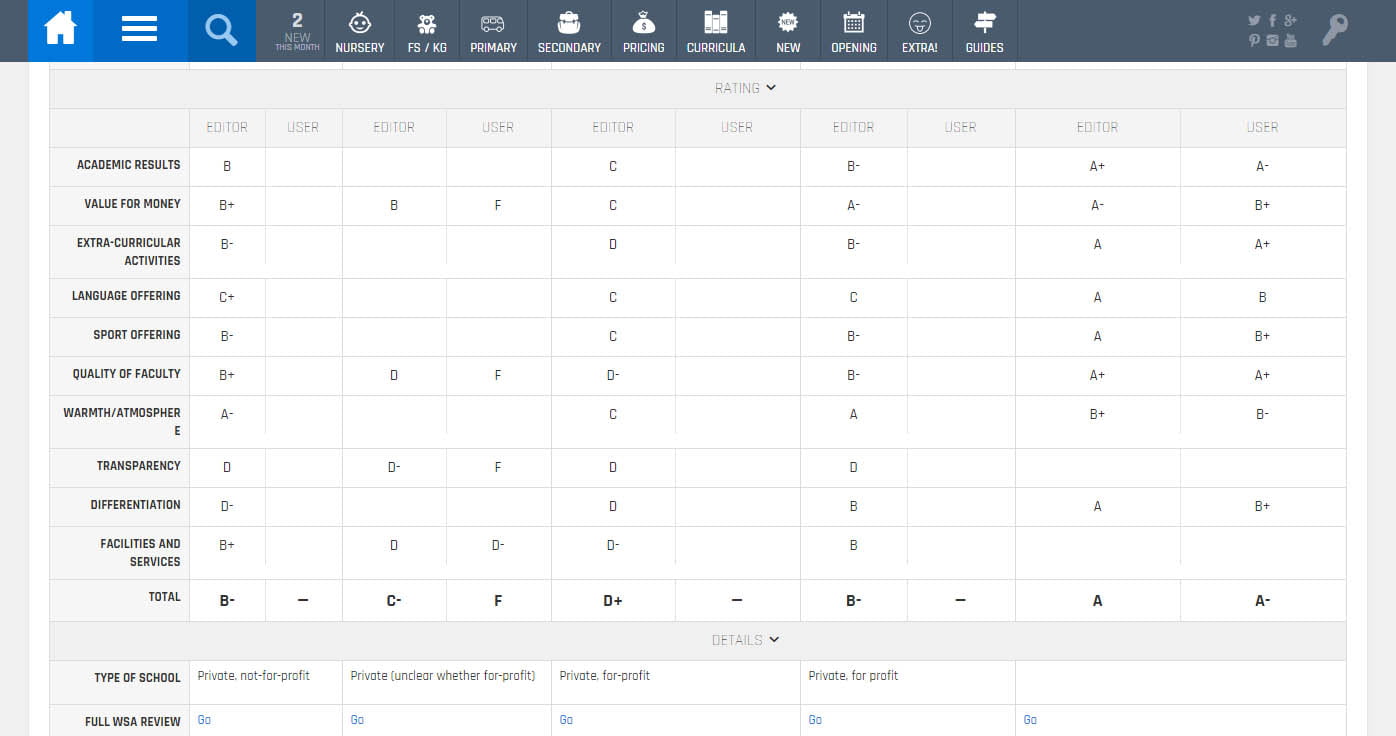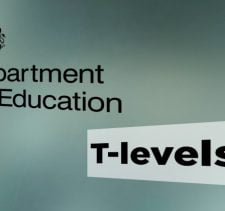How to Use Our Reviews and Compare
To add a school to a comparison page, simply click on the Compare button you will find at the top of each review!

WhichSchoolAdvisor.com is in many ways our primary reference site. Its reviewers have forged strong and close relationships with schools in the UAE, and as a result its reviews are informed, indepth and insightful.
WhichSchoolAdvisor.com gets you as close through that last mile as a review site can. However, because it is an indepth look at what a school is like – at its best delivering a sense of what a school actually feels like to be in – it is less a tool for evaluating 10 or even 100s of schools, or for putting more objective data side by side. SchoolsCompared.com by contrast is precisely designed for doing that.
For parents at this stage, that have been busy doing their own research and drawing up evaluation criteria on excel documents, SchoolsCompared.com is for you. The UAE is far better served for comparative data than it has ever been, and our editors have been busy compiling the data prospective parents compile to make comparisons, while our tech team has been creating a site that allows easy comparisons.
While data on schools is far more available than it has been, we are not yet a UK or the US, where access to data is almost a right. Much data is voluntarily provided by schools and where this is the case, it is often difficult to make rational like for like decisions. Take, for example examination data. Most schools don’t provide it, some when it suits their stories, only a very few objectively, consistently year in, year out.
That said, the number of forward thinking schools is growing thanks we belive to the likes of WhichSchoolAdvisor.com whose editors lobby hard for the release of the information.WhichSchoolAdvisor.com gets you as close through that last mile as a review site can. However, because it is an indepth look at what a school is like – at its best delivering a sense of what a school actually feels like to be in – it is less a tool for evaluating 10 or even 100s of schools, or for putting more objective data side by side. SchoolsCompared.com by contrast has been designed precisely for that purpose. SchoolsCompared.com
We also extract information from the KHDA and ADEC inspection reports, to whom we owe a great deal. Every year their reports get better and more detailed, and they are an essential read and guide for parents. Like WhichSchoolAdvisor.com reviews, and perhaps even more so, these are highly detailed reports that should be read when you reach the stage of seriously considering a school. That said, we do not recommend looking ONLY at the overall school score, largely because this may include weighting on factors you may not consider important. WhichSchoolAdvisor.com has written on this here.
So what actually goes into our reviews? First, and foremost is the data we extract. Read on to get the full details of what we collect, why we collect it, and how it is important for you…
What you can compare
Type of school – Is the school For profit or Not for profit? The number of Not for profit schools in the UAE is now dwarved by For profit schools. Not for profit schools are older, generally rated Good or Outstanding, and difficult to get into. Private schools provide the depth to the UAE’s education landscape with hundreds of schools crossing curricula, gender, levels and so on. Not for Profit schools do not turn a profit, but they are not cheap – most are Premium schools in terms of fees. However, 100 percent of fees will be returned to the school in teacher salaries, training, facilities and administration. There are no shareholders, and therefore no coupon or dividend payments.
WSA Good School – Is the school rated a WhichSchoolAdvisor.com Good School. Any school that has this badge comes with the highest recommendation.
Full WSA Review – A link to the full WhichSchoolAdvisor.com review of the school. WSA reviews are more likely to go into the feel of a school – what it looks, feels, smells like, how the teachers interact with children and so on.
Average Cost Per Year – Here we detail the complete fee structure of the school. We put each year on a separate line so when you compare two or more schools it is easier to make like for like comparisons.
Curriculum – The exact curricula a school follows – e.g. GCSE followed by the IB Diploma Programme for post 16 education. Many parents begin at this point wanting an A’ Level, CBSE, or an IB based school.
External Exam Boards – The specific examination boards used by a school. This is particularly important if a student is transferring to a school in the UAE mid way through a programme of study. The same exam board may not be the complete solution (schools may tackle the order of modules differently, or even choose different modules) but it will help east transition.
IB DipM Pass Rate – This is usually a pretty high percentage. You would hope the school will have guided students on their aptitude for the IBDipM long before the exam.
IB DipM Average Grade – This is a key piece of information assessing an IB based school. If the school does not provide this information, ask. Please note however results will vary based on how selective the school is, and the size of the student body. To get into a good UK university, 34 points will be required. 41 points or more are required for Oxbridge entrance.
Number of A Levels offered – Clearly how many A’ Levels a school offers is a key piece of information determining the breadth of the schools offering. Schools with less reources tend to have a more focused offering, and in the UAE this is usually around the sciences. Clearly it costs to employ teachers for specific subjects, and that will be reflected in tuition fees. Premium schools tend to have the most diverse offering, and tend to be the most likely to marry a “whole child” approach with the course offering to back that up.
A Levels offered – The exact A’ Levels offered
A Level A* to A – One of the most widely quoted stats for A Levels, A* to A grades are often requirements for tier 1 universities.
A Level A* to C – Probably the most widely quoted figure for A’ Level results. Gives a good indication of the likelihood the student body will be able to move into tertiary education.
IGCSE A* to C – Schools usually quote this with English and Maths, and also 5 A* to C with English and Maths, which is usually the minimum requirement to move onto study A’ Levels.
IGCSE A* to A – The percentage of students getting the top IGCSE grades
Number of I/GCSEs Offered – Again this will reflect the diversity of subject areas the school is able to cover.
I/GCSEs offered – Specific subjects offered.
Selective – Is the school selective on academic or other criteria? Dubai College for example is academically selective, Nord Anglia Dubai selective, but on more rounded criteria. If your child is academic, then targeting a selective school may make sense. Selective schools naturally do significantly better in examinations, and if selective intake is combined with world class teaching, the results too can be world class – Dubai College would be top 10 UK school in examination league tables.
Waiting list- If a school is heavily oversubscribed you need to weigh your desire to get your child into the school, with the chances of them actually getting in. If all you target are schools with long weighting lists, then you may end up with no place for your child. You will moreover be poorer. Schools charge application fees to ensure they are not inundated by 1000s of parents trying their luck.
Value Added – Very few schools publish this information, although we believe many more have it available. A school’s value added score in simple terms is the difference between the predicted outcomes of a child on entrance, and what he/she gets in practice. The difference is the value the school has added in terms of teaching and overall care.
Number of Students – The size of the school your child will be entering.
Teacher to Student Ratio – Gives a good indication of classroom sizes, as well as the breadth of courses offered.
Largest nationality teachers – Where teachers are recruited from.
Teacher turnover – Published where available and for the previous period. If the figure is high, ask the school why. 19% and below would be within a UAE norm.
Year opened – The year the school opened. Gives you an indication of how established the school is, the newness or otherwise of its facilities, how likely policies and procedures will have bedded in, fees (the newer the school normally the higher the fees), and difficulties getting in. Good rated schools less than 5/6 years old are normally considerably easier to get into than older schools with a similar rating. One reason for this is very simply that the UAE still operates very much on “word of mouth”, and newer schools have less mindshare. It may also have to do with fees (newer schools cost more) and location (older schools can be more centrally located, although not in newer parts of the city).
Location – Clearly this will matter to you. Even if you do not do the picking up and the dropping off, your children do not want to be stuck in traffic every day if it can be helped.
Student composition – We are usually able to extract the largest nationalities within a school.
Gender – Most schools in the UAE are mixed, however there are some that are boys or girls only, and some separate at a specific grade or year.
School canteen – Does the school have a canteen. We believe healthy food is essential for a healthy mind. A school canteen is a minimum requirement for this, although clearly every parent should assess the kinds of foods it serves.
Owner – Who owns the school? Many schools are owned by large groups – GEMs Education, Aldar, Taaleem… However many are not. It can make a difference. Aldar and GEMs schools do have brand values and promise which a parent may or may not buy into…
Admissions Telephone – The school’s contact number.
Web Address – School’s in the UAE are beginning to really improve their web presence, however it is still rare to find a good looking information that actually has valuable information. Do check the school’s web site, however. It can have information you will not find elsewhere, including information on open days, or for specific fees it charges in the application process.
KHDA/ADEC Rating – The overall ADEC or KHDA school rating. Note that these are weighted scores and you may not buy into the weighting. Making a decision based on them therefore will not always make sense. You need to drill down into each report to get full value from the reports. Fortunately we do a lot of this for you.
Attainment Nur SEM – This is the attainment score of the Foundation/KG stage of a school for Science English and Maths. To make these comparable, we have converted into a numerical score.
Attainment Pri SEM – This is the attainment score of the Primary stage of a school for Science English and Maths. To make these comparable, we have converted into a numerical score.
Attainment Sec SEM – This is the attainment score of the Secondary stage of a school for Science English and Maths. To make these comparable, we have converted into a numerical score.
Attainment Post-16 SEM – This is the attainment score of the Post-16 stage of a school for Science English and Maths. To make these comparable, we have converted into a numerical score.
Progress Nur SEM – This is the attainment score of the Foundation/KG stage of a school for Science English and Maths. To make these comparable, we have converted into a numerical score.
Progress Pri SEM – This is the progress score of the Primary stage of a school for Science English and Maths. To make these comparable, we have converted into a numerical score.
Progress Sec SEM – This is the progress score of the Secondary stage of a school for Science English and Maths. To make these comparable, we have converted into a numerical score.
Progress Post-16 SEM – This is the attainment score of the Post-16 stage of a school for Science English and Maths. To make these comparable, we have converted into a numerical score.
Arabic Native Primary Results (Native) – This is the attainment score of the primary stage of a school for Arabic Native. To make these comparable, we have converted into a numerical score.
Arabic Secondary Results (Native) – This is the attainment score of the secondary stage of a school for Arabic Native. To make these comparable, we have converted into a numerical score.
Arabic Post-16 Results (Native) – This is the attainment score of the Post-16 stage of a school for Arabic Native. To make these comparable, we have converted into a numerical score.
Arabic Primary Results (Add.) – This is the attainment score of the primary stage of a school for Arabic as a second language. To make these comparable, we have converted into a numerical score.
Arabic Secondary Results (Add.) – This is the attainment score of the secondary stage of a school for Arabic as a second language. To make these comparable, we have converted into a numerical score.
Arabic Post-16 Results (Add.) – This is the attainment score of the post-16 stage of a school for Arabic as a second language. To make these comparable, we have converted into a numerical score.
Islamic St. Primary Results – This is the attainment score of the primary stage of a school for Islamic Studies. To make these comparable, we have converted into a numerical score.
Islamic St. Secondary Results – This is the attainment score of the Secondary stage of a school for Islamic Studies. To make these comparable, we have converted into a numerical score.
Islamic St. Post-16 Results – This is the attainment score of the Post-16 stage of a school for Islamic Studies. To make these comparable, we have converted into a numerical score.
Leadership – How well the school is led, evaluating the strength of leadership and the clarity of vision in driving through change.
Community – The rating of the school for its sense of community.
Facilities – How comprehensive are the school’s facilities, how well they are maintained.
Quality of teaching – The rating of the school for the quality of its teaching.
Student personal responsibility – How students conduct themselves, and how well they take responsibility for their actions.
Quality of curriculum – The quality of the school’s curriculum, in theory and in practice.
School Governance – The rating of the school for its governance. How well a school is managed as a business.
SEN Provision – The quality and depth of the school’s approach to delivering Special Educational Needs (SEN) provision.
Finally, to help parents draw up their shortlist we have evaluated schools based on the following. Ratings are from A+ to F. There is both an Editors grade and a User grade. These grades are for guidance only. You should dig deep and make your own evaluations for any schools that make your final shortlist.
Academic Results – How well a school succeeds academically. We take note of whether a school is selective or non-selective. A school would score higher if non-selective and achieved the same results as a selective school.
Value for Money – The balance of fees to delivery of an holistic education.
Extra-Curricular Activities – The range, and cost, of extra curricular activities.
Language Offering – A specific assessment of that part of a curriculum that will prepare students for a world that speaks many languages.
Sport Offering – A diverse sport offering is key to health of students and a balance in the development of mind and body.
Quality of Faculty – An evaluation of the investment in teaching staff, recruitment depth (teacher:student ratio), investment in training (CPD), and teacher turnover.
Warmth/Atmosphere – How the school feels, its sense of community
Transparency – The quality of information the school releases to current and prospective parents
Differentiation – How well the school is able to tailor an educational experience for a specific child.
Facilities and Services – Not only the quality and depth of services and facilities, but how well these are used.
Total Score Override – our overall score, which is a result of the above scores.



















































